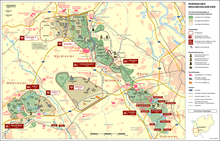Berrenrath opencast mine
| Berrenrath opencast mine | |||
|---|---|---|---|
| General information about the mine | |||
| Mining technology | Open pit | ||
| Overburden | approx. 125 million m³ | ||
| Funding / total | approx. 400 million tons of raw coal | ||
| Information about the mining company | |||
| Operating company |
Roddergrube ; later Rhine brown |
||
| Start of operation | 1914 | ||
| End of operation | 1970 | ||
| Successor use | Agricultural | ||
| Funded raw materials | |||
| Degradation of | Brown coal | ||
| Geographical location | |||
| Coordinates | 50 ° 52 '34.1 " N , 6 ° 50' 6.7" E | ||
|
|||
| Location | Berrenrath | ||
| local community | Huerth | ||
| District ( NUTS3 ) | Rhein-Erft district | ||
| country | State of North Rhine-Westphalia | ||
| Country | Germany | ||
| District | Rhenish lignite district | ||
The open pit Berrenrath (also pit Berrenrath , more rarely open pit Türnich called) is a former lignite - opencast mining in the Ville between Huerth and Kerpen - Türnich in the Rhenish mining area .
The opencast mine is named after the Berrenrath district of Hürth .
history
The opencast mine was opened up by the Roddergrube operating company in 1914/15 . The field was the field adjacent to the extensive concession area of the United Ville mine in the north , where lignite had been mined since 1901 .
With a seam thickness of approx. 38–40 m with only 13–15 m overburden , there was a favorable ratio of coal to overburden , which made mining very profitable. The coal obtained was used to supply nearby briquette factories , in particular the Berrenrath briquette factory and the United Ville briquette factory as well as the Goldenberg power station . The opencast mine worked in close coordination with the neighboring mines Götteshülfe and Hubertus , which were also subordinate to the Roddergrube. Earlier smaller pits (Mylius, Koepps, Gertrud and Gerhard ) opened up in the Berrenrath and Gotteshülfe / Theresia opencast mines. (→ main article lignite in Hürth )
As was customary in the region at the time, it was initially funded with a chain lift . The Berrenrath briquette factory in the north was supplied via an inclined elevator , while the United Ville and Goldenberg headquarters in the south were supplied via a 900 m long chain railway bridge . From 1923, the chain lift promotion was replaced by a more efficient promotion with large-capacity trucks. The wagons were first pulled by steam locomotives , later - because of the fire hazard - by electric locomotives. In 1928 the chain railway was shut down.
From 1928 until its destruction in 1944, the Berrenrath mine also supplied the briquette factory of the Ribbert Werke in Hermülheim , which had been supplied by the Engelbert mine until then . After the field was charred, the factory was also taken over by the Roddergrube. The raw coal was transported by cable car over Alt-Hürth. The other factories were supplied from the pits with a narrow-gauge coal railway following the mining zones, whose open-plan cars were also brought out of the pits via the inclined lifts that replaced the chain conveyors.
In the 1930s, the Roddergrube also took over the neighboring Friedrich Maximilian mine and expanded it into a modern open-cast mine called Berrenrath-West . In 1956 the two opencast mines grew together.
The sales of the factories, briquettes and pulverized coal, reached the port in Wesseling via the Villebahn . The hydrogenation plant in Wesseling, which was important for the war effort , was also supplied with pretreated coal .
After the Second World War, production was initially fully resumed. The sales conditions for briquettes became more and more difficult. From the 1960s onwards, this led to a gradual reduction in production, as the coal from the fields on the Ville was primarily used for briquetting because of its purity. So the coaling was delayed until the final shutdown of the mining operations of the Berrenrath mines in 1970. The power plants were supplied with steam coal from the northern underground mines, which were brought in via the north-south railway . The railway cut through the eastern already charred part of the Berrenrath opencast mine on a high dam .
Reclamation
The Berrenrath and Berrenrath-West (formerly Friedrich Maximilian ) opencast mines with their overburden dumps were recultivated from the mid-1960s under the direction of Gerhard Olschowy and converted into the Berrenrather Börde cultural landscape , which has long been considered a prime example of agricultural open- cast mining . In the middle of this Börde lies the hamlet of Berrenrath , with some resettled farmers from the northern underground mines.
Resettlement
Beyond the north-south railway embankment, in a part of the edge of the Berrenrath and Gotteshülfe pits, the town of Berrenrath, which was closed in the 1950s and no longer has any farms, lies. Other excavated hamlets are Ursfeld (1936), Aldenrath (1936) and Zieskoven . The few residents mostly settled in Gleuel. The mining settlement in Balkhausen was implemented within Balkhausen.
literature
- Walter Buschmann , Norbert Gilson, Barbara Rinn: Brown coal mining in the Rhineland , ed. from LVR and MBV-NRW , 2008, ISBN 978-3-88462-269-8
Individual evidence
- ^ A b c Karl-Günter Flohr: Operating history of the Berrenrath opencast mine. ( Memento from September 5, 2012 in the web archive archive.today )
- ↑ Recultivation Research Center: Berrenrath. ( Memento from February 1, 2014 in the Internet Archive )



